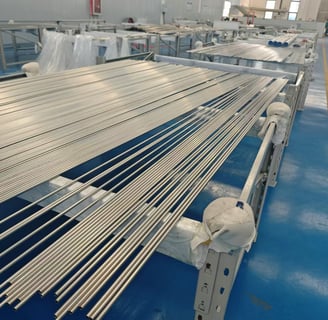Corrosion-Resistant Tubing for Industrial Use: Seamless vs. Welded
Learn about corrosion-resistant tubing for industrial use by comparing seamless and welded stainless steel options. Explore factors like durability, strength, and suitability to help you select the ideal tubing for high-performance, demanding environments
10/26/20242 min read


How to Determine the Quality of Seamless vs Welded Stainless Steel Tubing
When selecting stainless steel tubing, understanding the differences between seamless and welded tubing can help determine which is better suited for specific applications. Here, we’ll explore key factors that impact quality and performance in each type, such as durability, corrosion resistance, and manufacturing precision.
Seamless Stainless Steel Tubing
Advantages:
Higher Pressure Resistance: Seamless tubes lack welds, giving them strength and durability, which is essential for applications like oil and gas transportation where tubing must withstand high pressures.
Superior Corrosion Resistance: Without welded seams, seamless tubing resists corrosion better in extreme environments, making it ideal for the chemical processing, marine, and pharmaceutical industries.
Enhanced Aesthetic Appeal: Often, seamless tubing has a smoother appearance and is preferred for applications where visible tubing is essential, such as in architectural design.
Disadvantages:
Higher Cost: Due to the complex manufacturing process, seamless tubing is often more expensive than welded tubing.
Limited Customization Options: Seamless tubes have fewer size and length options compared to welded tubes.
Welded Stainless Steel Tubing
Advantages:
Cost-Effective: Welded tubes generally cost less to produce, making them a budget-friendly option for many applications, including automotive and structural projects.
Availability in Larger Sizes: Welded tubes offer flexibility in size, thickness, and length, which is valuable for custom projects or large-scale piping systems.
Sufficient Durability for General Use: Although not as strong as seamless tubing, welded tubing is adequate for less demanding applications.
Disadvantages:
Weld Line Vulnerability: The welded seam can be more susceptible to corrosion and cracking, especially in high-pressure environments.
Inconsistent Surface Quality: The welding process can result in imperfections along the seam, potentially impacting aesthetic requirements.
Choosing Between Seamless and Welded Tubing
To determine the ideal type, consider these factors:
Application Requirements: High-pressure and high-purity applications benefit more from seamless tubing, whereas cost-effective solutions can use welded tubing.
Environmental Conditions: Environments with high corrosive factors demand seamless tubing for longevity.
Budget Constraints: Welded tubing is suitable when the budget is limited, but strength and corrosion resistance are less critical.
Conclusion
Selecting the best stainless steel tubing depends on the specific needs of your project. Seamless tubing is ideal for demanding applications, while welded tubing is better suited for budget-conscious projects. Both types offer unique advantages, and understanding these can help make an informed choice for optimal performance and longevity.

Sheentube
High-quality stainless steel tubes for industries.
+86 15203012590
© 2024. All rights reserved.
